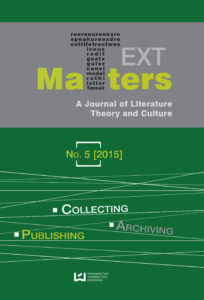Charles Willson Peale’s The Exhumation of the Mastodon and the Great Chain of Being: The Interaction of Religion, Science, and Art in Early-Federal America
DOI:
https://doi.org/10.1515/texmat-2015-0008Abstract
Although primarily known as a portrait painter, Charles Willson Peale (1741-1827) also possessed a profound interest in natural history. Indeed, Peale eventually founded the first natural history museum in the United States, and, during the end of the eighteenth century, he began to overlap his two great interests: art and nature. The event Peale chronicled in his 1804 painting The Exhumation of the Mastodon caused an extreme stir within the intellectual and religious circles of its time, and brought about, at the very least, a serious questioning in the deeply held notion of the Great Chain of Being. Although now largely discredited, this religious conviction postulated two concepts that Peale’s Exhumation of the Mastodon seemingly contradicts. The first was the belief that no animals since creation had suffered the fate of extinction. The second was a lack of belief in geological time. Indeed, one Irish clergyman calculated the actual date of creation to 4004 BCE.
In this paper, I explore Peale’s monumental painting, a work that is many things, a self-portrait and history painting among others. Indeed, in this painting, Peale was responding to science, religion, and their shifting positions within early-nineteenth-century America. When viewed together, Peale’s The Exhumation of the Mastodon is not merely a record of an event that occurred in New York during the early nineteenth century, and instead is a document of Peale and the interaction of science and religion in early-Federal America.
Downloads
References
Brigham, David R. Public Culture in the Early Republic: Peale’s Museum and Its Audience. Washington, D.C.: Smithsonian Institution P, 1995. Print.
Google Scholar
Bryson, Bill. A Short History of Nearly Everything. New York: Broadway, 2003. Print.
Google Scholar
Craven, Wayne. Colonial American Portraiture. New York: Cambridge UP, 1994. Print.
Google Scholar
Flexner, James Thomas. America’s Old Masters: Benjamin West, John Singleton Copley, Charles Willson Peale, and Gilbert Stuart. 1939. Reprint, New York: Dover Publications, 1994. Print.
Google Scholar
Hutton, James. Theory of the Earth with Proofs and Illustrations. Edinburgh: William Creech, 1795. Print.
Google Scholar
Jefferson, Thomas. Thomas Jefferson’s Notes on the State of Virginia. Ed. William Peden. 1784. Reprint, Chapel Hill: U of North Carolina P, 1955. Print.
Google Scholar
Lovejoy, Arthur O. The Great Chain of Being: A Study of the History of an Idea. 1936. Reprint, New York: Harper & Row, 1960. Print.
Google Scholar
Miller, Lillian B. “Charles Willson Peale as History Painter: The Exhumation of the Mastodon.” American Art Journal 13.1 (1981): 47-68. Print. doi: 10.2307/1594261
Google Scholar
Miller, Lillian B. ed. The Selected Papers of Charles Willson Peale and His Family, vol. 2, part 1 and 2: Charles Willson Peale: The Artist as Museum Keeper, 1791-1810. New Haven: Yale UP, 1988. Print.
Google Scholar
Orwell, George. 1984. New York: Signet-Penguin, 1950. Print.
Google Scholar
Richardson, Edgar P. Painting in America: The Story of 450 Years. New York: Crowell, 1956. Print.
Google Scholar
Richardson, Edgar P., Brooke Hindle, and Lillian B. Miller. Charles Willson Peale and His World. New York: Abrams, 1982. Print.
Google Scholar
Rigal, Laura. “Peale’s Mammoth.” American Iconology: New Approaches to Nineteenth-Century Art and Literature. Ed. David C. Miller. New Haven: Yale UP, 1993. 18-38. Print.
Google Scholar
Sellers, Charles Coleman. Mr. Peale’s Museum: Charles Willson Peale and the First Popular Museum of Natural Science and Art. New York: Norton, 1980. Print.
Google Scholar
Thomson, Keith Stewart. The Legacy of the Mastodon. New Haven: Yale UP, 2008.Print.
Google Scholar
Ussher, James. The Annals of the World. Ed. Larry Pierce. 1658. Reprint, Green Forest, AR: Master, 2003. Print.
Google Scholar
Ward, David C. Charles Willson Peale: Art and Selfhood in the Early Republic. Berkeley: U California P, 2004. Print.
Google Scholar
Downloads
Published
How to Cite
Issue
Section
License

This work is licensed under a Creative Commons Attribution-NonCommercial-NoDerivatives 4.0 International License.













